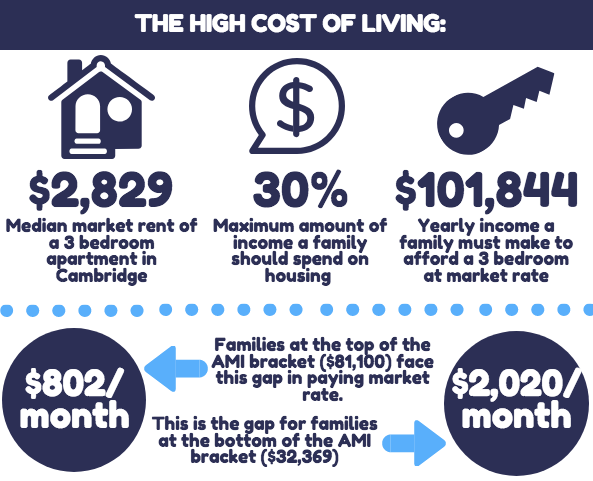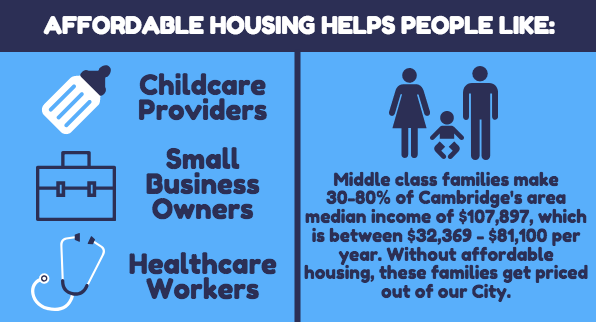
For too many in our Cambridge community, the cost of housing has reached a crisis level, and I am reminded of this nearly every week when I get emails from residents at their most vulnerable. They often face dramatic rent increases that create emergency situations, or are in danger themselves: a mother trying to escape a domestic violence situation, an elderly woman whose long-time home was just sold and is facing a no-fault eviction, an entire building of Section 8 tenants who were living affordably, but without leases and the legal standing as tenants that could protect them from displacement – and they are in immediate and dire need for housing.
As a Councillor, I have some, but not nearly enough, power to help them. I’ve written letters to vouch for Section 8 tenants’ credit to get them into inclusionary housing, or I’ve made calls to every realtor I know, trying to get an apartment for a single mom so her child can stay in Cambridge, finish high school, and graduate from CRLS. But these are band-aids on a systemic problem: that there’s just not enough housing to keep our most vulnerable residents in our community.

Many Cambridge residents have been following the Affordable Housing Overlay proposal with interest, and I have received hundreds of emails, particularly from residents who have questions, concerns, and those who outright oppose the proposal. To reassure residents, provide them with more details, and stem the tide of misinformation, I have replied to virtually every email and taken any meeting with residents who have questions about the Overlay to address their personal and specific concerns. But not all of you can, or feel comfortable, emailing the Council or showing up in person to Sullivan Chamber to speak at public comment. I’ve also noticed several recurring themes to residents’ concerns when they express them to me so I’m hoping to use this post to talk to our community all at once, not only to answer questions but also to be transparent in my thinking about this proposal as we move forward with this conversation as a community.
Why will there be different rules for affordable housing builders?
One of the reasons why we’re seeing a proliferation of luxury condo development is because of high land costs, an unpredictable and expensive zoning and permitting process, and the high costs of legal challenges to building projects. Affordable housing builders and nonprofits rely on already scarce Federal/HUD funding, State and City funding, with occasional contributions from other sources as well. Though the City has dramatically increased our contributions to affordable housing, we are not the sole financer of these projects, or even the largest ones. For most low income and affordable projects, nonprofits can apply for Federal and State funding, the source of the bulk of their financing, once a year in November, and zoning and permitting are required to be in place. If zoning complications arise, a single permit is denied, or they face a legal challenge, funding isn’t awarded, and they must wait an entire year before reapplying. Unlike large, for-profit developers, nonprofits cannot carry the expensive land costs for an entire year, which means the project doesn’t get built, and our community has lost a vital opportunity to produce low and middle income units. This is how we get the luxury-centered development that has frustrated so many in our City, including myself.

How long will units be affordable?
Developers reneging on their word and turning a profit on housing that was intended to help our community is a deep worry, and after what is happening with the Fresh Pond Apartments, what we call “expiring use” was a concern even before this draft zoning language was written. To ensure this never happens, every unit in every project will be deed-restricted, so that it remains affordable in-perpetuity and can never be converted into market-rate housing. This housing is protected specifically for individuals making between 30%-100% of the Area Median Income, or between $32,000-$107,000 annually, which means that residents like teachers, police officers, firefighters, retail shop employees, and home healthcare workers can have the housing stability they need.

How tall will buildings be in my neighborhood?
Building height is a concern for many who worry that their low-rise neighborhoods will be overwhelmed by larger structures. The proposal would allow buildings only up to 4 stories in residential areas, and they could only go up to 50’ if they contained an active ground floor use, and are located in a part of the neighborhood that is already home to businesses. Buildings that could reach up to 7 stories, or 80’, would only be allowed in major transit corridors, such as Massachusetts Ave. I have been advocating for a “middle tier”, because I think there are some identified “major transit corridors” that are too close to residential neighborhoods or are home to only 2-3 story buildings now, and would be more appropriate at 60’ rather than 80’. A good example of this is on Cambridge Street, between Inman Square and Lechmere station in East Cambridge. While these small, local businesses would benefit from the increased traffic that new residents would bring, the existing structures, even in the business district, are only 2-3 stories tall, and in my opinion, too closely abut residential neighborhoods to allow 80’. Instead, 60’ would allow the additional units without being out of context in these types of neighborhoods, which are typically located in BA districts on the zoning map.

Will the overlay take away green space?
Increasing the amount of green space in our City is something that’s important to me, as I think that residents who live in affordable developments should have just as much access to high quality green space as those who do not. Locating more residents in our City and near rapid transit will decrease the amount of “through traffic” and single car commuting trips, which is vital to reducing the effects of climate change as it allows residents to bike, walk, or take transit to work. Affordable and non-profit builders generally look to build on unused hard surface parking lots, or on lots with dilapidated buildings that could be rehabbed into energy-efficient housing, which would need to meet our City’s high green building standards. The Overlay would require that for fully affordable projects 30% of the lot to be green space, and half of that space must be permeable. If you look at the most recent Affordable Housing projects, sites like the old Kentucky Fried Chicken on Walden and Mass Ave., and the Concord Highland project on Concord Avenue, as well as missed opportunities due to this overlay not being in place, such as the Rite Aid in Porter Square or the Hondar House on Prospect Street, these were all previously lots with zero permeable or green space. By utilizing these lots to their full potential, we have a great opportunity to turn more space in our City from gray to green.
Will the overlay add too many new residents and deplete our resources?
Many residents are concerned about overcrowding, but the truth is that most of the units the Overlay produces will benefit people who are already residents of Cambridge – low and middle income people who are facing displacement or eviction, which is a concern of so many residents who are active in conversations about housing. The housing crisis is becoming so acute that both low and middle class families are shouldering housing costs that are so high, that they’re going without other essentials like food, proper nutrition, and medical care. As someone who has spent over five years in the non-profit sector, delivering food right into the homes of our most vulnerable residents, I’ve seen how disproportionately high housing costs have been detrimental to the quality of life of low-income seniors and residents with disabilities in particular and the devastating life choices they are forced to make when choosing home costs over critical medical care or food.
There are many other questions that residents have asked, but these are the most common themes and issues I’ve seen regarding the Affordable Housing Overlay. When so many emails voice similar concerns, those with starkly different tones stand out. I recently received yet another housing email from a resident in Cambridge, but the perspective and questions in this one were unique. It was from a lower-middle income family, living affordably now, but are just one untenable rent increase away from displacement. Unlike so many other emails, this is not an emergency situation, but the expression of a constant, nagging fear – an anxiety that lies in the back of their minds as they live their everyday life that home might not always be home. This resident wrote that while they want to keep living in Cambridge, they are increasingly seeing that it is not a community where everyone can thrive and participate fully. They also said something that resonated, and it’s what our overall messaging should be about the Overlay as a community: that they “wanted to know what they could do to help” in this time of crisis for so many, because “it’s not just about me.” They’re right. The Overlay is not just about us as individuals, but is one of our tools to remedy a systemic problem: that our overly-complicated Zoning Ordinance, which is intended to “preserve our community”, has not in fact, done that. Combined with the hot housing market, it has instead become a contributor to exclusion and displacement, and it’s our job as City leaders and policy makers to confront this challenge head on, and consider all opportunities to reverse these harmful effects.
The Affordable Housing Overlay proposal is one I support, but is still just that – a proposal. In my mind, it’s not perfect, and while nothing ever is, there are several aspects that need to be refined to make it a better fit to implement in our community. The draft zoning language continues to be a living document while it undergoes edits, and I am looking forward to the next step in this process which is discussing it in the Ordinance Committee amongst the full Council. I am grateful for the input and comments from our residents as we have had, and will continue to have this community-wide conversation.



 ut are still struggling to put food on the table. This all happens in a city of seemingly abundant affluence, and especially with the issue of hunger, the true need can be invisible. By bringing together two different City branches and a local nonprofit, I helped write a set of recommendations in the Free and Reduced Lunch Program Report that proposes allocating additional funds for free breakfast for all students in K-8 and DHSP programs. We are also eliminating the “reduced lunch” category so that the cost burden on needy families is zero, which will allow children to receive the nutritional assistance they need.
ut are still struggling to put food on the table. This all happens in a city of seemingly abundant affluence, and especially with the issue of hunger, the true need can be invisible. By bringing together two different City branches and a local nonprofit, I helped write a set of recommendations in the Free and Reduced Lunch Program Report that proposes allocating additional funds for free breakfast for all students in K-8 and DHSP programs. We are also eliminating the “reduced lunch” category so that the cost burden on needy families is zero, which will allow children to receive the nutritional assistance they need.